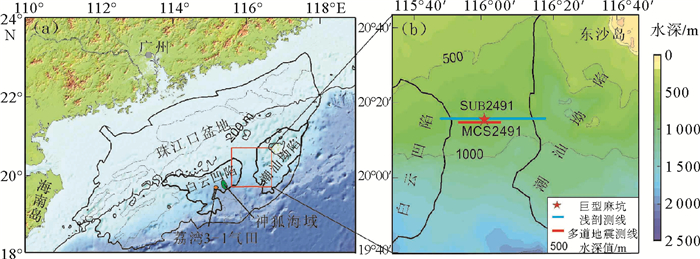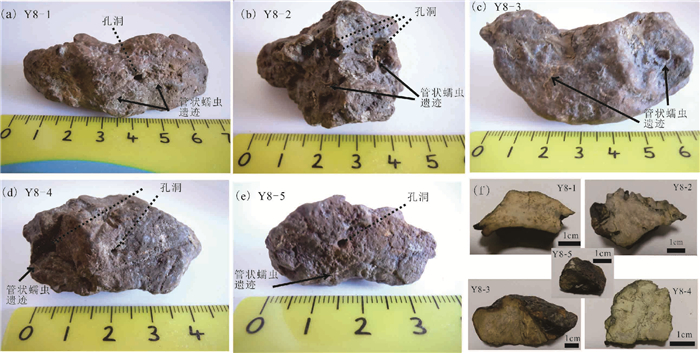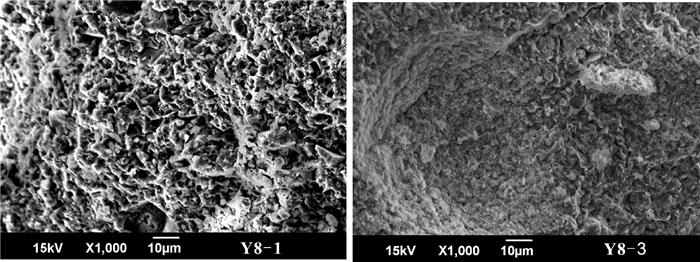CHARACTERISTICS OF AUTHIGENIC CARBONATES FROM A MEGA-POCKMARK ON THE EASTERN SIDE OF BAIYUN SAG,SOUTH CHINA SEA AND THEIR GEOLOGICAL SIGNIFICANCE
-
摘要: 探测发现南海白云凹陷东侧存在一个宽1 500 m、深达75 m的巨型麻坑,在麻坑内采集了大量的碳酸盐岩结核。大部分结核中存在新鲜孔洞和流体通道。本文从中选取了5块结核,进行XRD衍射、扫描电镜、碳氧同位素分析。结果表明,5个结核中碳酸盐矿物主要是含铁白云石,其中一个还有少量方解石,碎屑矿物主要是石英和长石。结核的显微结构以纤维状为主,存在裂隙和孔洞。δ13C值为-24.7‰~-10.9‰V-PDB,显示孔隙流体主要以热成因甲烷为主。δ18O值为5.6‰~6.9‰V-PDB,高值主要与天然气水合物分解有关。巨型麻坑海底之下最可能存在天然气水合物埋藏。含铁白云石结核在麻坑表层沉积物之下形成,随后出露海底。碳酸盐岩结核指示巨型麻坑内曾发生的甲烷渗漏活动可能与深部油气泄露有关,浅地层剖面中疑似气体羽和结核表面管状蠕虫活体都显示巨型麻坑仍在发生甲烷渗漏。Abstract: A mega-pockmark, 1 500 m in diameter and 75 m in depth, is discovered on the east side of the Baiyun Sag, the South China Sea. Many irregular nodules are collected from the mega-pockmark and most of them characterized by fresh holes and seep passages. The mineral composition, microstructures, stable carbon and oxygen isotopes (δ13C and δ18O) of the five authigenic carbonates are used to trace the fluid source and their forming environment. Mineralogical study suggests that the five carbonates are all dominated by ferrous dolomite, followed by a detrital fraction, mainly composed of quartz and feldspar. The δ13C of the five carbonates falls in the range of -24.7‰~-10.9‰, indicating a primary source of 13C-depleted thermogenic methane. The δ18O of five carbonates varies between 5.6‰~6.9‰ V-PDB, indicating that the 18O-rich fluids are derived from the decomposition of gas hydrates and/or dehydration of clay minerals at depth. Gas hydrate may have existed in the sediment of the mega-pockmark. Ferrous dolomites in authigenic carbonates are formed in sediments and subsequently exposed to the seawater, indicating that the old methane seep was related to deep oil and gas seepage in the mega-pockmark. The live tubeworms and gas plumes in the pockmark suggest that methane seep is still active nowadays.
-
海底麻坑主要是由于海底以下的流体通过运移通道向海底强烈快速喷溢或缓慢渗漏,剥蚀海底松散沉积物而形成大小不等的凹坑[1]。大多数海底麻坑直径一般不超过300m,以10~250m居多,深度多为1~25m[2]。海底麻坑的形成演化多与断层、裂隙等地质构造密切相关[3-7]。海底麻坑通常还与深部流体向海底运移的通道相连,且流体渗漏对海洋甚至大气环境造成重要影响[8]。海底麻坑中流体渗漏过程中经过甲烷厌氧氧化作用(Anaerobic Oxidation of Methane,简称为AOM),易于沉淀自生碳酸盐岩[9, 10]。部分麻坑内流体向上运移过程中还能形成天然气水合物[11]。因此,海底麻坑对油气埋藏、天然气水合物、流体渗漏、海底地质构造和海洋环境的研究具有重要意义,已经成为海洋地质学的研究热点之一。
海底麻坑中自生碳酸盐岩的矿物组成及其碳氧同位素(δ13C和δ18O)的研究主要分布在挪威海[9, 12]、北海[13]、刚果盆地[10, 14, 15]和地中海[16]等。这些海底麻坑中自生碳酸盐岩的δ13C和δ18O指示了甲烷渗漏活动以及流体中不同的碳氧来源,而矿物组成主要是文石、方解石和白云石等,不同的矿物组成与岩石沉淀期间流体中硫酸根浓度变化等因素有关。近年来在南海西北部海域——莺歌海盆地、西沙隆起、珠江口盆地、琼东南盆地、中建南盆地陆续发现了大小不等的海底麻坑,并利用地球物理、柱状沉积物地球化学等方法对麻坑的特征、成因、活动性及其与流体活动关系进行了研究[8, 17-23]。但对南海巨型麻坑中自生碳酸盐岩的特征及其流体渗漏活动的研究未见报道。
2014年我们在南海北部白云凹陷和潮汕坳陷之间较宽(60~80 km)的过渡带海域做多道地震反射剖面时,发现了宽为1 500 m、深度为75m的巨型麻坑,在麻坑中采集了大量的碳酸盐岩结核。白云凹陷属于重要的气田和天然气水合物的埋藏区[24, 25],潮汕坳陷存在泥火山构造,是油气勘探的前景区[26],而两者之间过渡带是以往油气和水合物研究报道的薄弱区,更对过渡带上巨型麻坑中自生碳酸盐岩特征和流体渗漏活动知之甚少。因此本文采集了巨型麻坑中自生碳酸盐岩,分析其矿物组成、显微结构、碳氧同位素特征等,结合浅地层数据和多道地震数据等,使用地球化学和地球物理等方法综合揭示自生碳酸盐岩的特征及其地质意义。
1. 地质背景
白云凹陷和潮汕坳陷是南海北部两个构造单元(图 1a)。白云凹陷新生代沉积厚度超过10000m,是南海北部基底最深的凹陷,是一个重要的深水油气和天然气水合物发育区[24]。白云凹陷内不仅有荔湾3-1大型深水气田[24],而且2007年我国首次钻获天然气水合物和2017年成功试采天然气水合物都在白云凹陷神狐海区[25, 27]。潮汕坳陷具有新生代沉积薄(500~1 000 m),中生代沉积厚(最厚可达6 000m)的特点[28, 29],最近发现了泥火山等构造单元,可能存在天然气泄漏[26]。
白云凹陷和潮汕坳陷之间存在一较宽(60~80km)的过渡带,是以往油气和水合物研究报道的薄弱区[30]。2014年我们搭载基金委共享航次“实验2号”实测了浅地层剖面测线SUB2491和多道地震测线MCS2491,两条测线位置如图 1b所示,SUB2491与MCS2491平行,间隔距离为50m左右。MCS2491测线只穿过巨型麻坑,两端未到白云凹陷和潮汕坳陷。而SUB2491测线的两段分别为白云凹陷和潮汕坳陷。SUB2491和MCS2491测线都发现海底存在一个小幅隆起,隆起中部存在一个宽达1 500 m、深75m左右的巨型麻坑(图 1b)。
2. 研究方法
2.1 样品采集
浅地层剖面测线SUB2491和多道地震反射测线MCS2491的剖面如图 2所示,依据剖面坐标拟设了巨型麻坑中采样点位置。2014年10月乘载“实验三号”考察船在巨型麻坑中Y8站点进行了抓斗取样,水深为743 m(图 2)。Y8站点沉积物中不仅含有许多结核,结核表面含有管状蠕虫活体,采集上来后不久死亡,还发现有孔虫、贝壳、螺、海胆等大量生物碎屑。将采集到的结核挑出,另用样品袋分装,编号保存。
![]() 图 2 SUB2491浅地层剖面和巨型麻坑中Y8采样点(a)、Y8附近SUB2491 浅地层剖面的放大图(b)及MCS2491多道地震剖面图和Y8采样点(c)Figure 2. (a)sub-bottom data along survey line SUB2491 and sample location in the mega-pockmark, (b)sub-bottom data close to sample location Y8 along survey line SUB2491, (c)multichannel seismic data of survey line MCS2491 and sample location Y8 in the mega-pockmark
图 2 SUB2491浅地层剖面和巨型麻坑中Y8采样点(a)、Y8附近SUB2491 浅地层剖面的放大图(b)及MCS2491多道地震剖面图和Y8采样点(c)Figure 2. (a)sub-bottom data along survey line SUB2491 and sample location in the mega-pockmark, (b)sub-bottom data close to sample location Y8 along survey line SUB2491, (c)multichannel seismic data of survey line MCS2491 and sample location Y8 in the mega-pockmark2.2 样品处理与分析
碳酸盐岩结核送至实验室后立即用清水冲洗,用超声波清洗约15 min后自然风干。选取的5个碳酸盐岩结核编号分别为Y8-1、Y8-2、Y8-3、Y8-4和Y8-5,均呈块状,分别长7、4、6.5、4.5和3.5cm。其中Y8-1,Y8-2,Y8-4和Y8-5四块结核上面均有孔洞,其未被碳酸盐或沉积物充填,多数孔洞为毫米级,最大约为2~3mm(图 3a, b, d, e),而Y8-3没有孔洞(图 3c)。5块碳酸盐结核表面,除了管状蠕虫活体,还分布有数量较多管状蠕虫遗迹(图 3a-e)。蠕虫个体一般长1~2 cm,最长达4cm,虫管为圆柱形,并呈弯曲状,直径为1~3mm。5块碳酸盐岩表层呈现棕褐色,切开后呈现浅黄色或灰白色等(图 3f)。
将切开的碳酸盐岩分成两份,一份用来进行显微结构观察,一份用玛瑙碾钵磨细至200目,将磨好的样品分成两份,分别进行XRD衍射分析和碳氧同位素分析。
XRD衍射分析:测试仪器为理学DMAX RapidⅡ型点光源面探测器X射线衍射仪,靶材-Mo (Mo Kα =0.710 73Å),功率50kV-90mA,准直管(入射线束斑直径)0.1mm,样品管直径0.5mm无背景样品管,曝光时间9min。本实验在南京大学内生金属矿床国家重点实验室的XRD实验室完成。
扫描电镜:选取新鲜样品断面固定之后在表面喷金,采用Carl Zeiss Supra55型号的扫描电镜JEOL JSM6490,测量的场发射加速电压为15kV,束斑大小为2μm。本实验在南京大学内生金属矿床国家重点实验室的扫描电镜分析室完成。
碳氧同位素测试分析采用磷酸法。δ13C和δ18O分析仪器为MAT253型稳定同位素比质谱仪。样品测试是通过kielⅣ的碳酸盐装置酸化,在70℃温度下样品与磷酸反应产生CO2进入主机进行测定,仪器测量时校准通过NBS19的标样进行。δ13C和δ18O值采用VPDB标准(Vienna PeeDee Belemnite)。重复分析实验室标样得到δ13C的标准偏差小于0.02‰V-PDB,δ18O的标准偏差小于0.03‰V-PDB。本实验在中国科学院南海海洋研究所完成。
3. 结果分析
3.1 矿物组成
XRD样品分析结果如表 1所示,Y8-1、Y8-2、Y8-3、Y8-4和Y8-5主要碳酸盐矿物是含铁白云石,碎屑矿物主要是石英和长石,黏土矿物主要是伊利石等。其中Y8-3主要碳酸盐矿物除了含铁白云石外,还含少量的方解石。Y8-1—Y8-5结核中含铁白云石是根据Gregg等讨论中XRD中有序反射识别出来的[31]。
表 1 5个自生碳酸盐岩的矿物组成Table 1. Mineral composition of the five authigenic carbonates样品 碳酸盐矿物 碎屑矿物 黏土矿物 Y8-1 含铁白云石 石英与长石 伊利石 Y8-2 含铁白云石 石英与长石 伊利石 Y8-3 含铁白云石,少量的方解石 石英与长石 伊利石 Y8-4 含铁白云石 石英与长石 伊利石 Y8-5 含铁白云石 石英与长石 伊利石 3.2 扫描电镜结果
Y8-1、Y8-2、Y8-4和Y8-5的碳酸盐岩结核扫描电镜图类似,均显示显微结构为纤维状结构,存在裂隙和孔洞。用Y8-1显微结构图来做代表分析,Y8-1存在2~4μm的裂隙和10μm左右孔洞(图 4)。Y8-1的能谱呈现出以Ca和Mg元素为主,大部分能谱显示Fe含量小于Mg含量,即Y8-1以含铁白云石为主,个别能谱显示Fe含量大于Mg含量。Y8-3呈现致密块状结构,少见裂隙和孔洞(图 4),Y8-3的能谱呈现出以Ca和Mg元素为主,含有Fe元素。
3.3 碳氧同位素
自生碳酸盐岩的碳、氧同位素分析结果如表 2所示,5个样品δ13C为-24.7‰~-10.9‰,平均值为-17.9‰,δ18O为5.6‰~6.9‰,平均值为6.3‰,具有轻度13C亏损和18O富集特征。
表 2 5个自生碳酸盐岩的δ13C和δ18O值Table 2. δ13C and δ18O of the five authigenic carbonates样品 δ13C/‰ δ18O/‰ Y8-1 -18.8 6.5 Y8-2 -10.9 6 Y8-3 -12.1 5.6 Y8-4 -24.7 6.7 Y8-5 -22.9 6.9 4. 讨论
4.1 自生碳酸盐岩中碳氧来源
研究区自生碳酸盐岩的δ13C为-24.7‰~-10.9‰,δ18O为5.6‰~6.9‰,同世界上尼日尔水下三角洲麻坑[32]、墨西哥湾Green Canyon[33, 34]、黑海泥火山[35]、加的斯湾中达尔文泥火山[36]、哥斯达黎加消减带Mound#11[37]、加州Monterey湾San Gregorio断裂带[38]等的甲烷成因碳酸盐岩δ13C和δ18O值范围相近,这些自生碳酸盐岩与深部的热成因甲烷泄漏和富氧的流体有关。
自生碳酸盐岩中碳可能来自不同成因的甲烷流体,分为热成因甲烷和生物成因甲烷。生物成因甲烷主要来自地层浅部,而热成因甲烷由来自地层深部的高压流体携带[39]。热成因甲烷来源自生碳酸盐岩具有δ13C相对较重(-10‰~-30‰V-PDB)的特点,而生物成因甲烷的碳酸盐岩具有更轻的δ13C值(-40‰~-75‰V-PDB)[39]。还有可能的来源途径为:石油中烃类化合物的δ13C值为-25‰~-35‰[40];海水δ13C为0‰[38]。由于研究区样品δ13C为-24.7‰~-10.9‰,因此, 判断研究区渗漏流体来自于δ13C值较重的碳源,最可能主要来自深部油气藏渗漏的热成因甲烷,也可能来自于石油烃或海水无机碳的混合。
自生碳酸盐岩样品δ18O组成是由多个因素控制,包括:(1)样品的矿物学和化学,(2)碳酸盐岩形成时的温度,(3)孔隙流体同位素组成[38],即δ18O反映了矿物组成、形成时流体组成以及碳酸盐岩析出时温度。由于5块结核主要的碳酸盐矿物均以含铁白云石为主,那么样品就受到碳酸盐岩形成时温度和流体同位素组成的影响,所以自生碳酸盐岩样品中δ18O主要反映了流体组成和温度的差异。计算白云石沉淀时孔隙流体组成,首先假设白云石形成时的最小温度为8 ℃,这个温度值是在冰期重建过程中2000m水深时最小的温度[41]。按照白云石-海水热平衡方程[42],按照含铁白云石δ18O最大值为6.9‰V-PDB计算,研究区流体同位素组成最少为2.5‰V-SMOW。在形成白云石的其他海域环境下,其孔隙流体组成最小值是不同的,如加的斯湾孔隙流体最小值超过2.5‰V-SMOW[41]和2.0~4.4‰V-SMOW范围[43]。两种因素会使δ18O值升高:一种是天然气水合物分解,另一种为黏土矿物脱水[39]。韩喜球等得出黏土矿物脱水发生在海底以下10 km左右,温度为60~130℃[39]。研究区巨型麻坑下1~3km区域的温压条件不能满足蒙脱石向伊利石发生完全转化,可能未达到黏土矿物脱水的条件。因此,研究区孔隙中富氧流体最可能主要与天然气水合物分解有关,因为巨型麻坑中部丘状隆起可能是海底天然气水合物埋藏膨胀导致的(图 2b)。
4.2 巨型麻坑自生碳酸盐岩的地质意义
多道地震反射剖面MCS2491显示:巨型麻坑下面存在一个底辟构造(图 5)。底辟是含流体的沉积物在超压条件下发生流动或塑性形变导致地层上拱形成的穹隆或蘑菇状构造。巨型麻坑中还存在一个丘状构造(图 5)。许多人研究了麻坑内部丘状构造与天然气水合物埋藏的关系。如Riboulot等定量模拟发现,麻坑内部的丘状构造可能是天然气水合物埋藏膨胀引起[44]。Hovland和Svensen认为挪威Nyegga海域麻坑中的丘状体与天然气水合物体积膨胀有关[11]。Lu等研究表明巨型麻坑下存在<100m厚的天然气水合物层[23]。因此, 研究区巨型麻坑中丘状构造与天然气水合物埋藏膨胀有关, 也就是说巨型麻坑底部最可能存在天然气水合物埋藏。
自生碳酸盐岩不同矿物组分可以指示不同的沉积环境。文石易于沉淀在海底沉积物-水体界面附近高SO42-含量的环境下,而高镁方解石和白云石形成于较深沉积物中低SO2-4含量的环境下[10, 43, 45]。巨型麻坑中碳酸盐岩矿物组成主要是含铁白云石,说明结核沉淀于SO42-含量低的较深地层。自生碳酸盐岩中石英和长石碎屑矿物含量较高,也说明自生碳酸盐岩形成在表层沉积物以下。这与自生碳酸盐岩白云石形成于表层沉积物以下的研究结果一致[37, 43, 46]。当强烈的微生物活动去除孔隙水中SO42-时,白云石就可以发生沉淀[47]。Zhang等实验得出白云石形成过程中硫化物和硫酸盐还原细菌可能同时起作用[48]。高甲烷渗漏环境下易于沉淀白云石,如Jørgensen发现烟囱状自生碳酸盐岩中白云石是甲烷大量渗漏的阶段形成,而甲烷低渗漏的时间段形成高镁方解石和文石[49]。沉积物中白云石的沉淀指示了甲烷流体的快速渗漏[50]。浅地层剖面SUB2491发现疑似气体羽可能预示着巨型麻坑区甲烷气体仍在发生渗漏,而且渗漏活动较强(图 2b)。巨型麻坑中自生碳酸盐岩中白云石含铁,可能是甲烷渗漏活动形成局部的强还原环境,导致铁锰氧化物发生反应释放出Fe,成为含铁白云石中铁元素来源,这与东沙西南断裂带自生碳酸盐岩中铁元素的成因类似[51]。由于巨型麻坑中自生碳酸盐岩结核以含铁白云石为主,说明结核形成在一个甲烷渗漏较强、表层沉积物以下和微生物活跃的环境。
巨型麻坑中自生碳酸盐岩含铁白云石形成后,甲烷流体刺穿上覆地层到海底,底辟顶部上覆沉积物部分被剥离,表层沉积物中细颗粒物质被甲烷流体向上带入海水或旁侧沉积物中,导致麻坑形成并逐步扩大。这种巨型麻坑的形成与南海莺歌海盆地的麻坑[17]和挪威Nyegga海域麻坑的成因类似[52]。巨型麻坑中自生碳酸盐岩的岩石外貌和显微结构显示,岩石外部和内部存在大小不一的孔洞和裂隙(图 3和图 4),清楚地表明它们在形成过程中及形成后很可能都受到甲烷流体的影响。巨型麻坑中自生碳酸盐岩结核出露后,大量管状蠕虫在甲烷渗漏处和自生碳酸盐岩表面附近生长。Sahling等曾研究过甲烷流体活动形成了Kouilou麻坑群中三种环境,其中管状蠕虫和自生碳酸盐岩出现的麻坑环境,甲烷供应量最高[53]。墨西哥湾北部卤水麻坑中,高含量甲烷滋养了管状蠕虫[54]。巨型麻坑中管状蠕虫死亡后附着在自生碳酸盐岩表层。巨型麻坑中碳酸盐岩结核指示麻坑曾发生的甲烷活动可能与深部油气泄露有关,而疑似气体羽和管状蠕虫活体等生物发现显示巨型麻坑仍在发生甲烷渗漏。
5. 结论
(1) 南海北部白云凹陷东侧巨型麻坑中采集到的5块自生碳酸盐岩呈结核状,碳酸盐岩结核长3.5~7 cm,其中4块岩石上面有孔洞,最大约2~3 mm宽。结核表面有管状蠕虫遗迹,表皮呈棕褐色,切开后呈灰白色或浅黄色。
(2) 5块自生碳酸盐岩自生矿物主要是含铁白云石,其中一块含有少量的方解石,碎屑矿物以石英和长石为主。自生碳酸盐岩显微结构以纤维状为主,富含裂缝和孔隙。δ13C值为-24.7‰~-10.9‰V-PDB,显示孔隙流体主要以热成因甲烷为主。δ18O值为5.6‰~6.9‰V-PDB,高值主要与天然气水合物分解有关。
(3) 巨型麻坑下部可能存在天然气水合物埋藏,来自深部的热成因甲烷渗漏活动较强,自生碳酸盐岩结核在表层沉积物之下形成,之后出露海底。自生碳酸盐岩指示巨型麻坑过去的甲烷活动可能与深部油气泄露有关,而疑似气体羽和管状蠕虫活体等显示巨型麻坑仍在发生甲烷渗漏。
-
图 2 SUB2491浅地层剖面和巨型麻坑中Y8采样点(a)、Y8附近SUB2491 浅地层剖面的放大图(b)及MCS2491多道地震剖面图和Y8采样点(c)
Figure 2. (a)sub-bottom data along survey line SUB2491 and sample location in the mega-pockmark, (b)sub-bottom data close to sample location Y8 along survey line SUB2491, (c)multichannel seismic data of survey line MCS2491 and sample location Y8 in the mega-pockmark
表 1 5个自生碳酸盐岩的矿物组成
Table 1 Mineral composition of the five authigenic carbonates
样品 碳酸盐矿物 碎屑矿物 黏土矿物 Y8-1 含铁白云石 石英与长石 伊利石 Y8-2 含铁白云石 石英与长石 伊利石 Y8-3 含铁白云石,少量的方解石 石英与长石 伊利石 Y8-4 含铁白云石 石英与长石 伊利石 Y8-5 含铁白云石 石英与长石 伊利石 表 2 5个自生碳酸盐岩的δ13C和δ18O值
Table 2 δ13C and δ18O of the five authigenic carbonates
样品 δ13C/‰ δ18O/‰ Y8-1 -18.8 6.5 Y8-2 -10.9 6 Y8-3 -12.1 5.6 Y8-4 -24.7 6.7 Y8-5 -22.9 6.9 -
[1] 罗敏, 吴庐山, 陈多福. 海底麻坑研究现状及进展[J]. 海洋地质前沿, 2012, 28(5): 33-42. http://hydt.cbpt.cnki.net/WKA/WebPublication/index.aspx?mid=hydt LUO Min, WU Lushan, CHEN Duofu. Research status and progress of seabed pockmarks[J]. Marine Geology Frontiers, 2012, 28(5): 33-42. http://hydt.cbpt.cnki.net/WKA/WebPublication/index.aspx?mid=hydt
[2] Pilcher R, Argent J. Mega-pockmarks and linear pockmark trains on the West African continental margin[J]. Marine Geology, 2007, 244(1-4): 15-32. doi: 10.1016/j.margeo.2007.05.002
[3] Gay A, Lopez M, Cochonat P, et al. Isolated seafloor pockmarks linked to BSRs, fluid chimneys, polygonal faults and stacked Oligocene-Miocene turbiditic palaeochannels in the Lower Congo Basin[J]. Marine Geology, 2006, 226(1-2): 25-40. doi: 10.1016/j.margeo.2005.09.018
[4] Dondurur D, Çifçi G, Drahor M G, et al. Acoustic evidence of shallow gas accumulations and active pockmarks in the ⅰzmir Gulf, Aegean sea[J]. Marine and Petroleum Geology, 2011, 28(8): 1505-1516. doi: 10.1016/j.marpetgeo.2011.05.001
[5] Reiche S, Hjelstuen B O, Haflidason H. High-resolution seismic stratigraphy, sedimentary processes and the origin of seabed cracks and pockmarks at Nyegga, mid-Norwegian margin[J]. Marine Geology, 2011, 284(1-4): 28-39. doi: 10.1016/j.margeo.2011.03.006
[6] Benjamin U, Huuse M, Hodgetts D. Canyon-confined pockmarks on the western Niger Delta slope[J]. Journal of African Earth Sciences, 2015, 107: 15-27. doi: 10.1016/j.jafrearsci.2015.03.019
[7] Wenau S, Spieβ V, Pape T, et al. Controlling mechanisms of giant deep water pockmarks in the Lower Congo Basin[J]. Marine and Petroleum Geology, 2017, 83: 140-157.
[8] Luo M, Chen L Y, Wang S H, et al. Pockmark activity inferred from pore water geochemistry in shallow sediments of the pockmark field in southwestern Xisha Uplift, northwestern South China Sea[J]. Marine and Petroleum Geology, 2013, 48: 247-259. doi: 10.1016/j.marpetgeo.2013.08.018
[9] Mazzini A, Svensen H, Hovland M, et al. Comparison and implications from strikingly different authigenic carbonates in a Nyegga complex pockmark, G11, Norwegian Sea[J]. Marine Geology, 2006, 231(1-4): 89-102. doi: 10.1016/j.margeo.2006.05.012
[10] Haas A, Peckmann J, Elvert M, et al. Patterns of carbonate authigenesis at the Kouilou pockmarks on the Congo deep-sea fan[J]. Marine Geology, 2010, 268(1-4): 129-136. doi: 10.1016/j.margeo.2009.10.027
[11] Hovland M, Svensen H. Submarine pingoes: Indicators of shallow gas hydrates in a pockmark at Nyegga, Norwegian Sea[J]. Marine Geology, 2006, 228(1-4): 15-23. doi: 10.1016/j.margeo.2005.12.005
[12] 冯先翠, 王伟, 王文倩, 等. 挪威海Nyegga麻坑区的甲烷成因自生碳酸盐岩[J]. 地球化学, 2015, 44(4): 348-359. doi: 10.3969/j.issn.0379-1726.2015.04.004 FENG Xiancui, WANG Wei, WANG Wenqian, et al. Methane-derived authigenic carbonates in Nyegga pockmarks, offshore Mid-Norway[J]. Geochimica, 2015, 44(4): 348-359. doi: 10.3969/j.issn.0379-1726.2015.04.004
[13] Mazzini A, Svensen H H, Planke S, et al. Pockmarks and methanogenic carbonates above the giant Troll gas field in the Norwegian North Sea[J]. Marine Geology, 2016, 373: 26-38. doi: 10.1016/j.margeo.2015.12.012
[14] Feng D, Chen D F, Peckmann J, et al. Authigenic carbonates from methane seeps of the northern Congo fan: microbial formation mechanism[J]. Marine and Petroleum Geology, 2010, 27(4): 748-756. doi: 10.1016/j.marpetgeo.2009.08.006
[15] Pierre C, Blanc-Valleron M M, Demange J, et al. Authigenic carbonates from active methane seeps offshore southwest Africa[J]. Geo-Marine Letters, 2012, 32(5-6): 501-513. doi: 10.1007/s00367-012-0295-x
[16] Gontharet S, Pierre C, Blanc-Valleron M M, et al. Nature and origin of diagenetic carbonate crusts and concretions from mud volcanoes and pockmarks of the Nile deep-sea fan (eastern Mediterranean Sea)[J]. Deep Sea Research Part Ⅱ: Topical Studies in Oceanography, 2007, 54(11-13): 1292-1311. doi: 10.1016/j.dsr2.2007.04.007
[17] 邸鹏飞, 黄华谷, 黄保家, 等. 莺歌海盆地海底麻坑的形成与泥底辟发育和流体活动的关系[J]. 热带海洋学报, 2012, 31(5): 26-36. doi: 10.3969/j.issn.1009-5470.2012.05.005 DI Pengfei, HUANG Huagu, HUANG Baojia, et al. Seabed pockmark formation associated with mud diapir development and fluid activities in the Yinggehai Basin of the South China Sea[J]. Journal of Tropical Oceanography, 2012, 31(5): 26-36. doi: 10.3969/j.issn.1009-5470.2012.05.005
[18] Sun Q L, Wu S G, Hovland M, et al. The morphologies and genesis of mega-pockmarks near the Xisha Uplift, South China Sea[J]. Marine and Petroleum Geology, 2011, 28(6): 1146-1156. doi: 10.1016/j.marpetgeo.2011.03.003
[19] 关永贤, 罗敏, 陈琳莹, 等. 南海西部海底巨型麻坑活动性示踪研究[J]. 地球化学, 2014, 43(6): 628-639. http://d.old.wanfangdata.com.cn/Periodical/dqhx201406007 GUAN Yongxian, LUO Min, CHEN Linying, et al. Tracing study on the activity of mega-pockmarks in southwestern Xisha Uplift, South China Sea[J]. Geochimica, 2014, 43(6): 628-639. http://d.old.wanfangdata.com.cn/Periodical/dqhx201406007
[20] Sun Q L, Wu S G, Cartwright J, et al. Shallow gas and focused fluid flow systems in the Pearl River Mouth Basin, northern South China Sea[J]. Marine Geology, 2012, 315-318: 1-14. doi: 10.1016/j.margeo.2012.05.003
[21] 拜阳, 宋海斌, 关永贤, 等. 利用反射地震和多波束资料研究南海西北部麻坑的结构特征与成因[J]. 地球物理学报, 2014, 57(7): 2208-2222. doi: 10.6038/cjg20140716 BAI Yang, SONG Haibin, GUAN Yongxian, et al. Structural characteristics and genesis of pockmarks in the northwest of the South China Sea derived from reflective seismic and multibeam data[J]. Chinese Journal of Geophysics, 57(7): 2208-2222. doi: 10.6038/cjg20140716
[22] Chen J X, Song H B, Guan Y X, et al. Morphologies, classification and genesis of pockmarks, mud volcanoes and associated fluid escape features in the northern Zhongjiannan Basin, South China Sea[J]. Deep Sea Research Part Ⅱ: Topical Studies in Oceanography, 2015, 122: 106-117. doi: 10.1016/j.dsr2.2015.11.007
[23] Lu Y T, Luan X W, Lyu F L, et al. Seismic evidence and formation mechanism of gas hydrates in the Zhongjiannan Basin, Western margin of the South China Sea[J]. Marine and Petroleum Geology, 2017, 84: 274-288. doi: 10.1016/j.marpetgeo.2017.04.005
[24] 何家雄, 施小斌, 夏斌, 等. 南海北部边缘盆地油气勘探现状与深水油气资源前景[J]. 地球科学进展, 2007, 22(3): 261-270. doi: 10.3321/j.issn:1001-8166.2007.03.006 HE Jiaxiong, SHI Xiaobin, XIA Bin, et al. The satus of the petroleum exploration in the northern South China sea and the resource potential in the deep-water areas[J]. Advances in earth science, 2007, 22(3): 261-270. doi: 10.3321/j.issn:1001-8166.2007.03.006
[25] 张洪涛, 张海启, 祝有海. 中国天然气水合物调查研究现状及其进展[J]. 中国地质, 2007, 34(6): 953-961. doi: 10.3969/j.issn.1000-3657.2007.06.001 ZHANG Hongtao, ZHANG Haiqi, ZHU Youhai. Gas hydrate investigation and research in China: present status and progress[J]. Geology in China, 2007, 34(6): 953-961. doi: 10.3969/j.issn.1000-3657.2007.06.001
[26] Yan P, Wang Y L, Liu J, et al. Discovery of the southwest Dongsha Island mud volcanoes amid the northern margin of the South China Sea[J]. Marine and Petroleum Geology, 2017, 88: 858-870. doi: 10.1016/j.marpetgeo.2017.09.021
[27] 天工. 我国海域天然气水合物试采成功[J]. 天然气工业, 2017, 37(5): 37. CNKI:SUN:TRQG.0.2017-05-007 TIAN Gong. Gas hydrate in South China Sea was exploited successfully for the first time[J]. Natural Gas Industry, 2017, 37(5): 37. CNKI:SUN:TRQG.0.2017-05-007
[28] 杨少坤, 林鹤鸣, 郝沪军. 珠江口盆地东部中生界海相油气勘探前景[J]. 石油学报, 2002, 23(5): 28-33. doi: 10.3321/j.issn:0253-2697.2002.05.006 YANG Shaokun, LIN Heming, HAO Hujun. Oil and gas exploration prospect of mesozoic in the eastern part of pearl river mouth basin[J]. Acta Petrolei Sinica, 2002, 23(5): 28-33. doi: 10.3321/j.issn:0253-2697.2002.05.006
[29] 阎贫, 王彦林, 郑红波. 南海北部白云凹陷-东沙岛西南海区的浅地层探测与深水沉积特点[J]. 热带海洋学报, 2011, 30(2): 115-122. doi: 10.3969/j.issn.1009-5470.2011.02.017 YAN Pin, WANG Yanlin, ZHENG Hongbo. Characteristics of deep water sedimentation revealed by sub-bottom profiler survey over the Baiyun Sag-Southwest Dongsha Island Waters in the northern South China Sea[J]. Journal of Tropical Oceanography, 2011, 30(2): 115-122. doi: 10.3969/j.issn.1009-5470.2011.02.017
[30] 阎贫, 王彦林, 郑红波, 等. 东沙群岛西南海区泥火山的地球物理特征[J]. 海洋学报, 2014, 36(7): 142-148. doi: 10.3969/j.issn.0253-4193.2014.07.016 YAN Pin, WANG Yanlin, ZHENG Hongbo, et al. Geophysical features of mud volcanoes in the waters southwest of the Dongsha Islands[J]. Acta Oceanologica Sinaca, 2014, 36(7): 142-148. doi: 10.3969/j.issn.0253-4193.2014.07.016
[31] Gregg J M, Bish D L, Kaczmarek S E, et al. Mineralogy, nucleation and growth of dolomite in the laboratory and sedimentary environment: a review[J]. Sedimentology, 2015, 62(6): 1749-1769. doi: 10.1111/sed.12202
[32] Rongemaille E, Bayon G, Pierre C, et al. Rare earth elements in cold seep carbonates from the Niger delta[J]. Chemical Geology, 2011, 286(3-4): 196-206. doi: 10.1016/j.chemgeo.2011.05.001
[33] Roberts H H, Feng D, Joye S B. Cold-seep carbonates of the middle and lower continental slope, northern Gulf of Mexico[J]. Deep-Sea Research Part Ⅱ: Topical Studies in Oceanography, 2010, 57(21-23): 2040-2054. doi: 10.1016/j.dsr2.2010.09.003
[34] Bian Y Y, Feng D, Roberts H H, et al. Tracing the evolution of seep fluids from authigenic carbonates: Green Canyon, northern Gulf of Mexico[J]. Marine and Petroleum Geology, 2013, 44: 71-81. doi: 10.1016/j.marpetgeo.2013.03.010
[35] Mazzini A, Ivanov M K, Parnell J, et al. Methane-related authigenic carbonates from the Black Sea: geochemical characterisation and relation to seeping fluids[J]. Marine Geology, 2004, 212(1-4): 153-181. doi: 10.1016/j.margeo.2004.08.001
[36] Vanneste H, Kastner M, James R H, et al. Authigenic carbonates from the Darwin Mud Volcano, Gulf of Cadiz: A record of palaeo-seepage of hydrocarbon bearing fluids[J]. Chemical Geology, 2012, 300-301: 24-39. doi: 10.1016/j.chemgeo.2012.01.006
[37] Han X Q, Suess E, Sahling H, et al. Fluid venting activity on the Costa Rica margin: new results from authigenic carbonates[J]. International Journal of Earth Sciences, 2004, 93(4): 596-611. doi: 10.1007/s00531-004-0402-y
[38] Stakes D S, Orange D, Paduan J B, et al. Cold-seeps and authigenic carbonate formation in Monterey Bay, California[J]. Marine Geology, 1999, 159(1-4): 93-109. doi: 10.1016/S0025-3227(98)00200-X
[39] 韩喜球, 杨克红, 黄永样. 南海东沙东北冷泉流体的来源和性质: 来自烟囱状冷泉碳酸盐岩的证据[J]. 科学通报, 2013, 58(19): 1865-1873. doi: 10.1360/csb2013-58-19-1865?slug=abstract HAN Xiqiu, YANG Kehong, HUANG Yongyang. Origin and nature of cold seep in northeastern Dongsha area, South China Sea: Evidence from chimney-like seep carbonates[J]. Chinese Science Bulletin, 2013, 58(30): 3689-3697. doi: 10.1360/csb2013-58-19-1865?slug=abstract
[40] 陈忠, 颜文, 陈木宏, 等. 南海北部大陆坡冷泉碳酸盐结核的发现: 海底天然气渗漏活动的新证据[J]. 科学通报, 2006, 51(9): 1065-1072. doi: 10.3321/j.issn:0023-074X.2006.09.011 CHEN Zhong, YAN Wen, CHEN Muhong, et al. Discovery of seep carbonate nodules as new evidence for gas venting on the northern continental slope of South China Sea[J]. Chinese Science Bulletin, 2006, 51(10): 1228-1237. doi: 10.3321/j.issn:0023-074X.2006.09.011
[41] Wang S H, Magalh es V H, Pinheiro L M, et al. Tracing the composition, fluid source and formation conditions of the methane-derived authigenic carbonates in the Gulf of Cadiz with rare earth elements and stable isotopes[J]. Marine and Petroleum Geology, 2015, 68: 192-205. doi: 10.1016/j.marpetgeo.2015.08.022
[42] Vasconcelos C, McKenzie J A, Warthmann R, et al. Calibration of the δ18O paleothermometer for dolomite precipitated in microbial cultures and natural environments[J]. Geology, 2005, 33(4): 317-320. doi: 10.1130/G20992.1
[43] Magalh es V H, Pinheiro L M, Ivanov M K, et al. Formation processes of methane-derived authigenic carbonates from the Gulf of Cadiz[J]. Sedimentary Geology, 2012, 243-244: 155-168. doi: 10.1016/j.sedgeo.2011.10.013
[44] Riboulot V, Sultan N, Imbert P, et al. Initiation of gas-hydrate pockmark in deep-water Nigeria: Geo-mechanical analysis and modelling[J]. Earth and Planetary Science Letters, 2016, 434: 252-263. doi: 10.1016/j.epsl.2015.11.047
[45] Greinert J, Bohrmann G, Suess E. Gas hydrate-associated carbonates and methane-venting at Hydrate Ridge: classification, distribution, and origin of authigenic lithologies[M]//Paull C K, Dillon W P. Natural Gas Hydrates: Occurrence, Distribution, and Dynamics. Washington D C: American Geophysical Union, 2001: 99-113.
[46] Viola I, MagalhĀes V, Pinheiro L M, et al. Mineralogy and geochemistry of authigenic carbonates from the Gulf of Cadiz[J]. Journal of Sea Research, 2014, 93: 12-22. doi: 10.1016/j.seares.2014.04.007
[47] 卞友艳, 陈多福. 海底冷泉环境中的白云石(岩)研究现状[J]. 矿物岩石地球化学通报, 2014, 33(2): 238-246. doi: 10.3969/j.issn.1007-2802.2014.02.012 BIAN Youyan, CHEN Duofu. Research progress of dolomite in seep carbonates[J]. Bulletin of Mineralogy, Petrology and Geochemistry, 2014, 33(2): 238-246. doi: 10.3969/j.issn.1007-2802.2014.02.012
[48] Zhang F F, Yan C, Teng H H, et al. In situ AFM observations of Ca-Mg carbonate crystallization catalyzed by dissolved sulfide: Implications for sedimentary dolomite formation[J]. Geochimica et Cosmochimica Acta, 2013, 105: 44-55. doi: 10.1016/j.gca.2012.11.010
[49] Jørgensen N O. Holocene methane-derived, dolomite-cemented sandstone pillars from the Kattegat, Denmark[J]. Marine Geology, 1989, 88(1-2): 71-81. doi: 10.1016/0025-3227(89)90005-4
[50] Takeuchi R, Matsumoto R, Ogihara S, et al. Methane-induced dolomite “chimneys” on the Kuroshima Knoll, Ryukyu islands, Japan[J]. Journal of Geochemical Exploration, 2007, 95(1-3): 16-28. doi: 10.1016/j.gexplo.2007.05.008
[51] 陈忠, 杨华平, 黄奇瑜, 等. 南海东沙西南海域冷泉碳酸盐岩特征及其意义[J]. 现代地质, 2008, 22(3): 382-389. doi: 10.3969/j.issn.1000-8527.2008.03.006 CHEN Zhong, YANG Huaping, HUANG Qiyu, et al. Diagenetic environment and implication of seep carbonate precipitations from the southwestern Dongsha area, South China Sea[J]. Geoscience, 2008, 22(3): 382-389. doi: 10.3969/j.issn.1000-8527.2008.03.006
[52] Hovland M, Svensen H, Forsberg C F, et al. Complex pockmarks with carbonate-ridges off mid-Norway: Products of sediment degassing[J]. Marine Geology, 2005, 218(1-4): 191-206. doi: 10.1016/j.margeo.2005.04.005
[53] Sahling H, Bohrmann G, Spiess V, et al. Pockmarks in the Northern Congo Fan area, SW Africa: Complex seafloor features shaped by fluid flow[J]. Marine Geology, 2008, 249(3-4): 206-225. doi: 10.1016/j.margeo.2007.11.010
[54] Macdonald I R, Neilly J F, Guinasso N L, et al. Chemosynthetic mussels at a brine-filled pockmark in the northern gulf of Mexico[J]. Science, 1990, 248(4959): 1096-1099. doi: 10.1126/science.248.4959.1096
-
期刊类型引用(5)
1. 时志强,彭深远,赵子腾. 上奥陶统五峰组海底麻坑沉积的首次识别及其地质意义. 古地理学报. 2024(02): 255-268 .  百度学术
百度学术
2. Pengfei Xiong,Cong Cheng,Zenggui Kuang,Jinfeng Ren,Jinqiang Liang,Hongfei Lai,Zigui Chen,Jiang Lu,Xiaoyu Fang,Tao Jiang. Sedimentary characteristics and genetic mechanism of the giant ancient pockmarks in the Qiongdongnan Basin, northern South China Sea. Acta Oceanologica Sinica. 2023(02): 120-133 .  必应学术
必应学术
3. 刘一林,李灿苹,勾丽敏,汪洪涛,曾宪军,陈凤英,郭子豪,田鑫裕. 冷泉羽状流地震波场频谱特征与气含量关系研究. 现代地质. 2022(01): 172-181 .  百度学术
百度学术
4. 刘一林,李灿苹,郭子豪,陈凤英,田鑫裕. 冷泉、羽状流与天然气水合物的联合探测分析. 地球物理学进展. 2022(02): 851-861 .  百度学术
百度学术
5. 魏纳,周守为,崔振军,赵金洲,张烈辉,赵军. 南海北部天然气水合物物性参数评价与分类体系构建. 天然气工业. 2020(08): 59-67 .  百度学术
百度学术
其他类型引用(3)




 下载:
下载:






